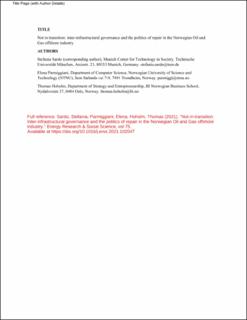| dc.contributor.author | Stefania, Sardo | |
| dc.contributor.author | Parmiggiani, Elena | |
| dc.contributor.author | Hoholm, Thomas | |
| dc.date.accessioned | 2021-03-30T07:45:32Z | |
| dc.date.available | 2021-03-30T07:45:32Z | |
| dc.date.created | 2021-03-27T11:19:36Z | |
| dc.date.issued | 2021 | |
| dc.identifier.citation | Energy Research & Social Science. 2021, 75, . | en_US |
| dc.identifier.issn | 2214-6296 | |
| dc.identifier.uri | https://hdl.handle.net/11250/2736059 | |
| dc.description.abstract | In the past three decades, there has been an increasing interest in transitions as crucial analytical moments of socio-technical change, with infrastructures being strategic loci from where to leverage these transformations. In this article, we argue for the necessity to re-engage with not-in-transition periods, which have theoretically and analytically been oversimplified. By focusing on the socio-technical practices of repair across interconnected infrastructures under not-in-transition conditions, we provide a better understanding of how these periods are (re)produced. Our in-depth case study of the Norwegian offshore oil and gas (O&G) drilling industry shows how stability can be ensured by means of inter-infrastructural governance carried on by specific power constellations, i.e. action nodes. The way they mould infrastructural components is revealed when normal operations are endangered by adverse events, such as accidents or economic crises. | en_US |
| dc.language.iso | eng | en_US |
| dc.publisher | Elsevier | en_US |
| dc.rights | Attribution-NonCommercial-NoDerivatives 4.0 Internasjonal | * |
| dc.rights.uri | http://creativecommons.org/licenses/by-nc-nd/4.0/deed.no | * |
| dc.subject | Makt og sosial struktur | en_US |
| dc.subject | Power and social structure | en_US |
| dc.subject | Governance | en_US |
| dc.subject | Governance | en_US |
| dc.subject | Informasjonsinfrastrukturer | en_US |
| dc.subject | Information Infrastructures | en_US |
| dc.subject | Offshore olje og gassindustrien | en_US |
| dc.subject | Offshore oil and gas industry | en_US |
| dc.title | Not in transition: Inter-infrastructural governance and the politics of repair in the Norwegian oil and gas offshore industry | en_US |
| dc.type | Peer reviewed | en_US |
| dc.type | Journal article | en_US |
| dc.description.version | acceptedVersion | en_US |
| dc.subject.nsi | VDP::Samfunnsvitenskap: 200 | en_US |
| dc.subject.nsi | VDP::Social sciences: 200 | en_US |
| dc.subject.nsi | VDP::Samfunnsvitenskap: 200 | en_US |
| dc.subject.nsi | VDP::Social sciences: 200 | en_US |
| dc.source.volume | 75 | en_US |
| dc.source.journal | Energy Research & Social Science | en_US |
| dc.identifier.doi | 10.1016/j.erss.2021.102047 | |
| dc.identifier.cristin | 1901441 | |
| dc.description.localcode | © 2021. This is the authors’ accepted and refereed manuscript to the article. Locked until 26. March 2023 due to copyright restrictions. This manuscript version is made available under the CC-BY-NC-ND 4.0 license http://creativecommons.org/licenses/by-nc-nd/4.0/ | en_US |
| dc.source.articlenumber | 102047 | en_US |
| cristin.ispublished | true | |
| cristin.fulltext | postprint | |
| cristin.qualitycode | 1 | |

